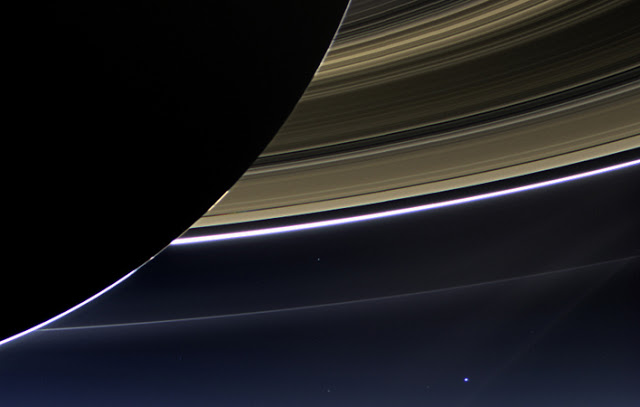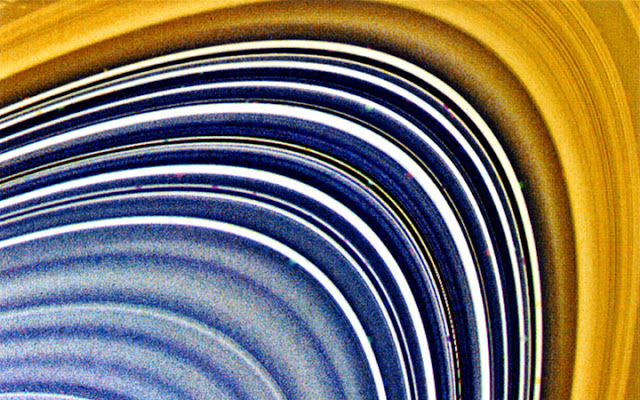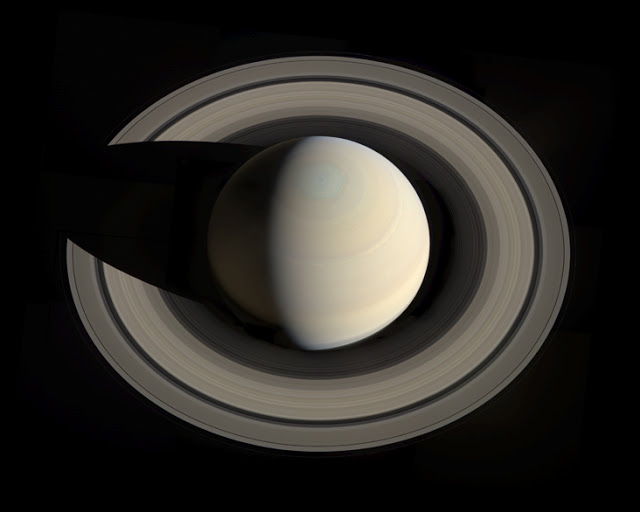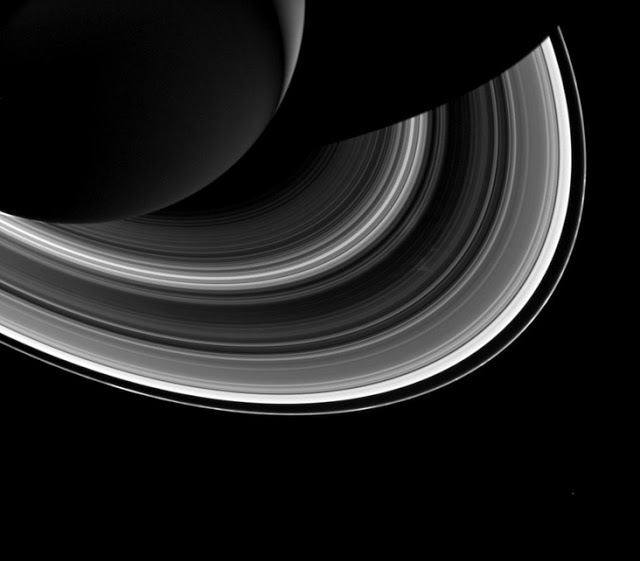| Online: | |
| Visits: | |
| Stories: |

| Story Views | |
| Now: | |
| Last Hour: | |
| Last 24 Hours: | |
| Total: | |
Supercomputer Tackles Saturn’s Rings
This is a Voyager 2 false-color image of Saturn’s rings. Subtle color variations due to differences in surface composition of the particles making up the rings are enhanced in this image produced by combining ultraviolet, clear, and orange frames.
A natural answer may be the following: Occasionally, in a far past, some planets had much more material in their vicinity then the other ones. The material was in a form of dust. Dust particles merged together, due to gravitational or adhesive forces, and larger and larger aggregates appeared in a system. This seems to be clear, but what had happened to the particles, when they ceased to grow, reaching a size of a house? What was a mechanism that hindered their further growth? It remained enigmatic. Moreover, the particle size distribution followed, with a high accuracy, a beautiful mathematical law of “inverse cubes”. This law, for instance, implies, that the abundance of particles of size 2 meters is 8 time less than that of particles of size 1 meter; the abundance of particles of size 3 meter is respectively 27 times less, and so on. The nature of this law was also a riddle.
This portrait looking down on Saturn and its rings was created from images obtained by NASA’s Cassini spacecraft on Oct. 10, 2013. It was made by amateur image processor and Cassini fan Gordan Ugarkovic. This image has not been geometrically corrected for shifts in the spacecraft perspective and still has some camera artifacts.The mosaic was created from 12 image footprints with red, blue and green filters from Cassini’s imaging science subsystem. Ugarkovic used full color sets for 11 of the footprints and red and blue images for one footprint.
An international team of scientists managed to resolve the above riddles of the particle size distribution in Saturn’s rings. The team had four Russians on board: a graduate of the M.V. Lomonosov Moscow State University Nikolai Brilliantov – presently professor at the University of Leicester in the UK, Pavel Krapivsky – presently professor at the Boston University in the USA, Anna Bodrova from the Chair of Polymer and Crystal Physics of the Faculty of Physics of the M.V. Lomonosov Moscow State Unversity and Vladimir Stadnichuk, from the same Chair of Polymer and Crystal Physics.
Among the interplay of Saturn’s shadow and rings, Mimas, which appears in the lower-right corner of the image, orbits Saturn as a set of the ever-intriguing spokes appear in the B ring (just to the right of center).
The magnificent Saturn Rings stretch by hundred of thousand kilometers outward from Saturn. In the other, perpendicular direction they are incredibly thin — only a few tens of meters, which makes the Saturn rings the most sharp object in nature, million times “sharper” than the sharpest razor. The rings consist of ice particle with a tiny addition of rocky material and orbit the planet with an enormous speed of 72,000 kilometers per hour. But this is an average or orbital speed, while the individual velocities have slightly different values. Commonly deviations from the orbital speed are extremely small, only a few meters per hour!
Scientists have constructed a mathematical model of the above processes in rings and studied this model by various methods. In particular, they solved numerically a vast system of differential equations. This could be efficiently done only with a use of a powerful supercomputer. This part of the work has been carried out by the Moscow part of the team, who exploited “Chebyshev” — the supercomputer of the M.V. Lomonosov Moscow State University. “Chebyshev”, named in honor of a famous Russian mathematician, is one of the most powerful computers in Europe.

In this rare image taken on 19 July 2013, the wide-angle camera on NASA’s Cassini spacecraft has captured Saturn’s rings and our planet Earth and its moon in the same frame.

Credit: NASA
The results of the study entail a number of other scientific conclusions, for example, concerning the mechanism of rings formation and evolution. The results show that the rings of Saturn are in a steady-state. Furthermore, since the characteristic time of the rings’ respond to any external perturbation does not exceed 10 000 years, nothing catastrophic has happened to the rings since the Bronze Age.
This is a Voyager image of Saturn rings. The color variations here indicate different chemical compositions in the rings.

Credit: NASA/JPL
“There’s nothing more practical than a good theory”. This statement, also attributed to a German-American psychologist Kurt Lewin, is totally relevant for the above research: The scientists have developed a rather universal mathematical tool, which could be straightforwardly applied to a variety of systems in nature and industry. Whenever a system is comprised of particles that can merge colliding at low velocities and break into small pieces colliding at large velocities, the size distribution of particles will demonstrate the amazing “inverse cubes” law.
Vladimir Koryagin
Source:





